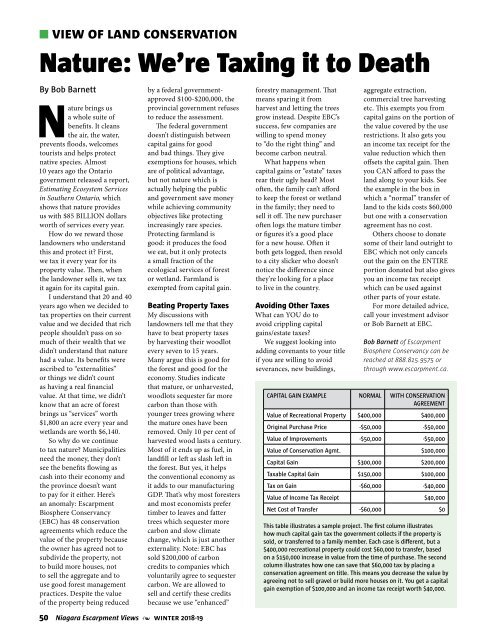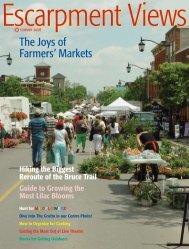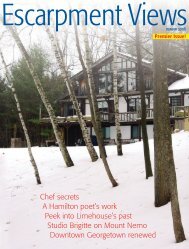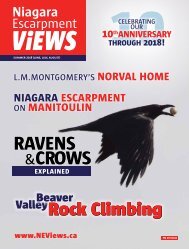Winter 2018 19 NEViews
Create successful ePaper yourself
Turn your PDF publications into a flip-book with our unique Google optimized e-Paper software.
n view of land conservation<br />
Nature: We’re Taxing it to Death<br />
By Bob Barnett<br />
Nature brings us<br />
a whole suite of<br />
benefits. It cleans<br />
the air, the water,<br />
prevents floods, welcomes<br />
tourists and helps protect<br />
native species. Almost<br />
10 years ago the Ontario<br />
government released a report,<br />
Estimating Ecosystem Services<br />
in Southern Ontario, which<br />
shows that nature provides<br />
us with $85 BILLION dollars<br />
worth of services every year.<br />
How do we reward those<br />
landowners who understand<br />
this and protect it? First,<br />
we tax it every year for its<br />
property value. Then, when<br />
the landowner sells it, we tax<br />
it again for its capital gain.<br />
I understand that 20 and 40<br />
years ago when we decided to<br />
tax properties on their current<br />
value and we decided that rich<br />
people shouldn’t pass on so<br />
much of their wealth that we<br />
didn’t understand that nature<br />
had a value. Its benefits were<br />
ascribed to “externalities”<br />
or things we didn’t count<br />
as having a real financial<br />
value. At that time, we didn’t<br />
know that an acre of forest<br />
brings us “services” worth<br />
$1,800 an acre every year and<br />
wetlands are worth $6,140.<br />
So why do we continue<br />
to tax nature? Municipalities<br />
need the money, they don’t<br />
see the benefits flowing as<br />
cash into their economy and<br />
the province doesn’t want<br />
to pay for it either. Here’s<br />
an anomaly: Escarpment<br />
Biosphere Conservancy<br />
(EBC) has 48 conservation<br />
agreements which reduce the<br />
value of the property because<br />
the owner has agreed not to<br />
subdivide the property, not<br />
to build more houses, not<br />
to sell the aggregate and to<br />
use good forest management<br />
practices. Despite the value<br />
of the property being reduced<br />
by a federal governmentapproved<br />
$100-$200,000, the<br />
provincial government refuses<br />
to reduce the assessment.<br />
The federal government<br />
doesn’t distinguish between<br />
capital gains for good<br />
and bad things. They give<br />
exemptions for houses, which<br />
are of political advantage,<br />
but not nature which is<br />
actually helping the public<br />
and government save money<br />
while achieving community<br />
objectives like protecting<br />
increasingly rare species.<br />
Protecting farmland is<br />
good: it produces the food<br />
we eat, but it only protects<br />
a small fraction of the<br />
ecological services of forest<br />
or wetland. Farmland is<br />
exempted from capital gain.<br />
Beating Property Taxes<br />
My discussions with<br />
landowners tell me that they<br />
have to beat property taxes<br />
by harvesting their woodlot<br />
every seven to 15 years.<br />
Many argue this is good for<br />
the forest and good for the<br />
economy. Studies indicate<br />
that mature, or unharvested,<br />
woodlots sequester far more<br />
carbon than those with<br />
younger trees growing where<br />
the mature ones have been<br />
removed. Only 10 per cent of<br />
harvested wood lasts a century.<br />
Most of it ends up as fuel, in<br />
landfill or left as slash left in<br />
the forest. But yes, it helps<br />
the conventional economy as<br />
it adds to our manufacturing<br />
GDP. That’s why most foresters<br />
and most economists prefer<br />
timber to leaves and fatter<br />
trees which sequester more<br />
carbon and slow climate<br />
change, which is just another<br />
externality. Note: EBC has<br />
sold $200,000 of carbon<br />
credits to companies which<br />
voluntarily agree to sequester<br />
carbon. We are allowed to<br />
sell and certify these credits<br />
because we use “enhanced”<br />
50 Niagara Escarpment Views • winter <strong>2018</strong>-<strong>19</strong><br />
forestry management. That<br />
means sparing it from<br />
harvest and letting the trees<br />
grow instead. Despite EBC’s<br />
success, few companies are<br />
willing to spend money<br />
to “do the right thing” and<br />
become carbon neutral.<br />
What happens when<br />
capital gains or “estate” taxes<br />
rear their ugly head? Most<br />
often, the family can’t afford<br />
to keep the forest or wetland<br />
in the family; they need to<br />
sell it off. The new purchaser<br />
often logs the mature timber<br />
or figures it’s a good place<br />
for a new house. Often it<br />
both gets logged, then resold<br />
to a city slicker who doesn’t<br />
notice the difference since<br />
they’re looking for a place<br />
to live in the country.<br />
Avoiding Other Taxes<br />
What can YOU do to<br />
avoid crippling capital<br />
gains/estate taxes?<br />
We suggest looking into<br />
adding covenants to your title<br />
if you are willing to avoid<br />
severances, new buildings,<br />
aggregate extraction,<br />
commercial tree harvesting<br />
etc. This exempts you from<br />
capital gains on the portion of<br />
the value covered by the use<br />
restrictions. It also gets you<br />
an income tax receipt for the<br />
value reduction which then<br />
offsets the capital gain. Then<br />
you CAN afford to pass the<br />
land along to your kids. See<br />
the example in the box in<br />
which a “normal” transfer of<br />
land to the kids costs $60,000<br />
but one with a conservation<br />
agreement has no cost.<br />
Others choose to donate<br />
some of their land outright to<br />
EBC which not only cancels<br />
out the gain on the ENTIRE<br />
portion donated but also gives<br />
you an income tax receipt<br />
which can be used against<br />
other parts of your estate.<br />
For more detailed advice,<br />
call your investment advisor<br />
or Bob Barnett at EBC.<br />
Bob Barnett of Escarpment<br />
Biosphere Conservancy can be<br />
reached at 888.815.9575 or<br />
through www.escarpment.ca.<br />
CAPITAL GAIN EXAMPLE NORMAL WITH CONSERVATION<br />
AGREEMENT<br />
Value of Recreational Property $400,000 $400,000<br />
Original Purchase Price -$50,000 -$50,000<br />
Value of Improvements -$50,000 -$50,000<br />
Value of Conservation Agmt. $100,000<br />
Capital Gain $300,000 $200,000<br />
Taxable Capital Gain $150,000 $100,000<br />
Tax on Gain -$60,000 -$40,000<br />
Value of Income Tax Receipt $40,000<br />
Net Cost of Transfer -$60,000 $0<br />
This table illustrates a sample project. The first column illustrates<br />
how much capital gain tax the government collects if the property is<br />
sold, or transferred to a family member. Each case is different, but a<br />
$400,000 recreational property could cost $60,000 to transfer, based<br />
on a $150,000 increase in value from the time of purchase. The second<br />
column illustrates how one can save that $60,000 tax by placing a<br />
conservation agreement on title. This means you decrease the value by<br />
agreeing not to sell gravel or build more houses on it. You get a capital<br />
gain exemption of $100,000 and an income tax receipt worth $40,000.
















